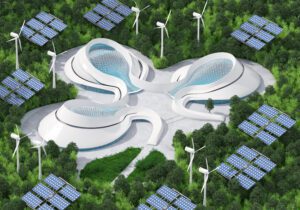The United Nations defines sustainable development to mean “meeting the needs of the present without compromising the ability of future generations to meet their own needs.” Thus, sustainability requires us to protect both natural resources and human health while using our available resources efficiently. The International Energy Agency estimates that more than half of global greenhouse gas emissions come from buildings alone; therefore, it is imperative that we invest in new technologies which improve energy efficiency while eliminating our dependence on fossil fuels.
The goal of sustainability is to ensure that human activities do not undermine the capacity of ecosystems to meet people’s needs, now and in the future. That’s why we need new technologies and scientific knowledge to help us achieve our goals for sustainable development. Achieving a sustainable future will require innovation of new energy sources, materials, and infrastructure, as well as changes in how we produce food, travel, and build homes. In this blog, we will look at the impact of science and technology for a sustainable future.
A Reflection on What Science and Technology Can Do for The Planet
In the last two hundred years, science and technology have helped us to understand our planet better. They have enabled us to discover new ways of living, improve our quality of life and protect the planet. Science and technology can play an important role in building a sustainable future.
Science and technology for a sustainable future help us understand our environment and our impact on it, which is essential for making smart decisions about how to use our resources. It can also help us find solutions to problems, such as climate change and pollution, and improve the quality of life for all people. The sustainable future that we envision will need to be driven by new materials and advanced energy sources. The development of these technologies is necessary to meet the growing demand for a better quality of life.
Innovation in science and technology is needed to:
- To reduce pollution
- To reduce energy consumption
- To reduce waste production and increase recycling capacity
- To enhance forest growth and reforestation
Technological Changes Will Be Needed to Drive Sustainability
Technology plays a fundamental role in driving sustainable development. The diversity of technologies and their multiple uses are key drivers of economic growth, employment creation, and social inclusion. At the same time, technological changes can unlock new opportunities for achieving environmental sustainability by changing production processes and product designs, changing consumption patterns, or improving resource efficiency – all needed to achieve a sustainable future.
Science and technology for a sustainable future are likely to be one of the most important factors in determining whether humanity will succeed at tackling some of its greatest challenges: managing climate change; ensuring access to clean water; eliminating poverty; meeting health needs worldwide while protecting biodiversity; developing alternatives renewable energy sources etc.
Some Examples of Science and Technology for Sustainable Future
1. Sustainable Energy
Sustainable energy is the use of sources of energy that can be consumed without causing significant damage to the environment. There are several different types of sustainable energy, including solar, wind, geothermal, hydroelectric and biomass. Renewable energy is a better choice than fossil fuels because it does not produce carbon dioxide or other greenhouse gases when it is used. The development and large-scale use of sustainable energy is a great example of sustainable technology.
2. Biotechnology
Biotechnology refers to the process of replacing polluting materials with sustainable alternatives. Therefore, this form of technology helps us achieve sustainability. For example, biotechnology has been used to produce genetically modified crops that require less water and fertiliser, which reduces the amount of pollution they produce. It’s also possible to use biotechnology in developing new ways of managing waste, improving clean energy production, and capturing CO2 emissions from industrial processes.
3. Smart Mobility
When it comes to sustainable transport, smart mobility is the new frontier. The need for smart mobility is driven by four factors: population growth, urbanisation, and pollution. These factors have led to an urgent need for better transportation solutions that can help us address our environmental challenges while improving the quality of life in the world’s growing cities. Smart mobility solutions will play a significant role in reducing traffic congestion and improving air quality in urban areas.
4. Sustainable Infrastructure
Sustainable infrastructure is the foundation for economic growth and social well-being. It includes all physical assets that provide services to the community, such as transportation systems, energy production facilities, water treatment plants, and wastewater treatment facilities. These physical assets are made up of functions supported by various technologies, such as electric power transmission lines or carbon capture equipment at power plants.
Sustainable Innovation with Schneider Electric
The future of our planet is at stake, and science and technology for a sustainable future are the only answers to our problems. We have reached a point where we can no longer rely on nature or traditional methods to provide us with energy, food, shelter, or materials. Instead, we need innovative technologies that allow us to manage our resources while reducing pollution and greenhouse gases sustainably. Science and technology for a sustainable future offer hope for a better tomorrow by allowing us to create sustainable solutions in every sector of society, from agriculture, transportation, and infrastructure development all the way up to smart cities.
At Schneider Electric, we are advocates of innovation in the field of sustainability. Ecostruxture, our IoT-enabled system, is one such innovation. Connecting nearly every single aspect of your business. Allowing you to act on real-time data and business logic. Allowing you to act on real-time data and business logic. Our EcoStruxure Platform enables intelligent interoperability, an integrated foundation for smart operations, and facilities for cloud-connected digital services.



